Before 2014, being diagnosed with chronic hepatitis C meant years of painful injections, brutal side effects, and no guarantee you’d be cured. Many people lived with the virus for decades, watching their liver slowly fail, afraid to tell friends, partners, or even family. Today, that story has changed - completely. You can now cure hepatitis C in as little as eight weeks with a simple pill, almost no side effects, and a better than 95% chance of success. This isn’t science fiction. It’s happening right now, in clinics, hospitals, and homes around the world.
What Chronic Hepatitis C Actually Does to Your Liver
Chronic hepatitis C isn’t just a virus in your blood. It’s a slow-burning fire inside your liver. For years, maybe decades, you might feel fine. No jaundice. No pain. No warning signs. But while you’re unaware, the virus is quietly attacking liver cells, triggering inflammation, scarring, and eventually, irreversible damage. Left untreated, about 20-30% of people with chronic hepatitis C will develop cirrhosis within 20 years. Some will go on to liver cancer or liver failure. That’s why it’s called a silent disease - it doesn’t scream until it’s too late.
The liver is one of the body’s most resilient organs. It can regenerate, repair, and keep working even when damaged. But hepatitis C doesn’t give it time. The virus hijacks liver cells to make copies of itself, and your immune system responds by attacking those infected cells. Over time, this constant battle turns healthy tissue into stiff, non-functional scar tissue. That’s fibrosis. When it spreads, it becomes cirrhosis - and once cirrhosis sets in, your risk of liver cancer jumps dramatically.
The Revolution: Direct-Acting Antivirals (DAAs)
The game-changer came in 2013 and 2014 with the arrival of direct-acting antivirals - or DAAs. These are not like the old interferon treatments that made patients feel like they had the flu for months. DAAs are oral pills. You take them once a day. No shots. No hospital visits. No debilitating fatigue or depression. And they work faster and better than anything before.
There are three main types of DAAs, each targeting a different part of the hepatitis C virus:
- NS3/4A protease inhibitors - like glecaprevir and voxilaprevir - stop the virus from cutting its proteins into usable pieces.
- NS5A inhibitors - like velpatasvir and pibrentasvir - block the virus from assembling new copies of itself.
- NS5B polymerase inhibitors - like sofosbuvir - stop the virus from copying its RNA, which is how it reproduces.
Most modern treatments combine two or three of these drugs into a single pill. That’s why you see names like Epclusa (sofosbuvir + velpatasvir) or Mavyret (glecaprevir + pibrentasvir). These are called pan-genotypic regimens because they work against all six major strains of hepatitis C. You don’t even need to know your genotype anymore - the same pill works for everyone.
How Effective Are These Pills?
The numbers are staggering. In clinical trials, DAAs cure more than 95% of patients. In real-world use - with people who have diabetes, HIV, kidney disease, or even advanced cirrhosis - the cure rate still hovers around 94-97%. Compare that to the old interferon and ribavirin combo, which cured only 40-80% of people after 6 to 12 months of treatment, and often left patients too sick to work or care for their families.
What’s more, the treatment time dropped from up to 48 weeks to just 8 or 12 weeks. For someone with cirrhosis, it might go up to 16 or 24 weeks - but even then, it’s far easier than the old way. And the side effects? Most people report nothing worse than mild fatigue or a headache. A 2023 Gilead survey of 5,000 patients found that 97% would recommend the treatment to a friend. One Reddit user wrote: “Cured in 12 weeks with Epclusa - only side effect was mild fatigue first week.” That’s the new normal.
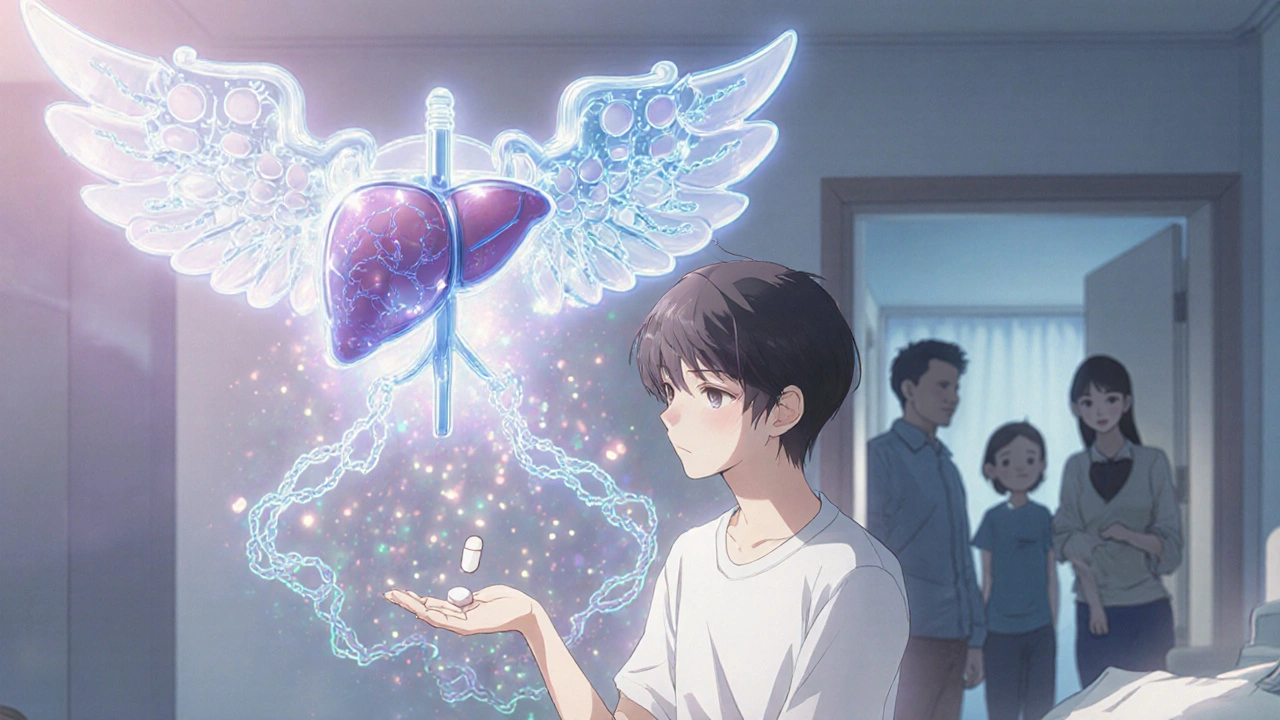
How Liver Protection Happens After the Cure
Curing the virus doesn’t just mean you’re no longer infectious. It means your liver starts healing. Studies show that once the virus is gone, fibrosis stops progressing in 95% of patients. In 70% of cases, the liver actually regenerates - scar tissue breaks down and is replaced by healthy tissue over the next 3 to 5 years. This isn’t theoretical. Liver biopsies and FibroScan tests taken before and after treatment confirm it.
For people who already had cirrhosis, the benefits are life-saving. The risk of liver failure drops by more than 80%. The chance of developing liver cancer falls by 70-80%. One study found that patients with cirrhosis who were cured had a 90% lower risk of dying from liver-related causes than those who remained infected.
And it’s not just physical. Many patients describe a psychological shift. One man in a Mayo Clinic interview said, “I finally felt like I could date again. I could get married. I could have kids.” Before, he lived in fear of transmitting the virus. After treatment, that fear vanished. That’s protection too - emotional, social, and relational.
Who Can Get Treated? Everyone - Even Kids
For years, treatment was limited to adults. Now, the World Health Organization recommends DAAs for children as young as three years old. There are no age limits anymore. Even people with kidney disease, HIV co-infection, or who’ve had liver transplants can be treated successfully. In fact, after liver transplants, the cure rate with DAAs is 94%, compared to just 25% with the old interferon therapy.
Primary care doctors can now prescribe these pills. You don’t need a liver specialist. The University of Washington found that after just four hours of training, clinicians were prescribing DAAs correctly 95% of the time. This is huge. It means treatment can happen in your neighborhood clinic, not just in big city hospitals.
Cost and Access - The Real Hurdle
The science is perfect. But access isn’t. In the U.S., a 12-week course of Mavyret or Epclusa still costs around $75,000. That’s a lot - even with insurance. Many patients face denials, prior authorizations, and delays. The CDC reports that 28% of patients had to fight their insurance just to get started.
But there’s hope. Generic versions of these drugs are now available in low- and middle-income countries for as little as $50 per course. Gilead and other manufacturers have programs to help uninsured patients. In the U.S., nonprofit organizations and state health departments often cover the cost for those who qualify. The real barrier isn’t the drug - it’s the system.
Worldwide, more than 10 million people have been cured since 2013. But only 20% of infected people even know they have it. That’s the biggest problem. You can’t cure what you don’t diagnose.

What About Reinfection?
If you’re cured, you’re not immune. You can get hepatitis C again - especially if you’re still injecting drugs, sharing needles, or engaging in high-risk behaviors. Studies show a 5-10% annual reinfection rate among people who inject drugs. That’s why treatment must go hand-in-hand with harm reduction: clean needles, education, and support services.
For others - people who got infected through blood transfusions or medical procedures decades ago - reinfection isn’t a concern. Once cured, they’re safe. The virus doesn’t come back on its own.
What If the First Treatment Doesn’t Work?
Most people are cured on the first try. But for 1-5% of patients - usually those who’ve failed multiple treatments before - the virus may still hang on. In those cases, there’s a backup: Vosevi (sofosbuvir + velpatasvir + voxilaprevir). It’s designed specifically for people who didn’t respond to earlier DAAs. It’s not first-line, but it’s there. And even then, cure rates are still above 90%.
What’s Next? Elimination by 2030
The World Health Organization wants to eliminate hepatitis C as a public health threat by 2030. That means reducing new infections by 90% and cutting deaths by 65%. It’s possible - but only if we screen more people, treat faster, and remove barriers to care.
Right now, the U.S. treats about 200,000 people a year. To meet the goal, we need to treat 400,000. That’s doable. The tools are here. The drugs work. The science is settled. What’s missing is the will - to test everyone at risk, to fund treatment for the uninsured, and to treat hepatitis C like the preventable, curable disease it is.
If you’ve ever been told you have hepatitis C - or if you’ve ever wondered if you might - know this: you don’t have to live with it. You don’t have to wait. You don’t have to suffer. There’s a pill. It works. And it can save your liver - and your life.
Can hepatitis C come back after being cured?
No, once you achieve a sustained virologic response (SVR) - meaning the virus is undetectable in your blood 12 weeks after finishing treatment - the virus is gone for good. However, you can be reinfected if you’re exposed again, especially through needle sharing or unsterile medical procedures. Being cured doesn’t give you immunity.
Do I need to get tested for hepatitis C if I feel fine?
Yes. Most people with chronic hepatitis C have no symptoms for decades. The CDC recommends one-time testing for all adults, especially those born between 1945 and 1965, people who’ve used injected drugs, or anyone who received a blood transfusion before 1992. A simple blood test can detect the virus before it causes liver damage.
Are there any side effects from DAA treatment?
Most people experience no side effects. The most common are mild fatigue, headache, or nausea - usually lasting only the first few days. These are far less severe than the flu-like symptoms, depression, and anemia caused by older interferon treatments. Serious side effects are rare.
Can I drink alcohol after being cured of hepatitis C?
It’s safest to avoid alcohol entirely, even after being cured. While the virus is gone, your liver may still have some scarring. Alcohol can slow healing and increase the risk of liver cancer or cirrhosis later on. If you had advanced liver disease before treatment, your doctor will likely advise lifelong abstinence.
Is hepatitis C treatment covered by insurance?
Most insurance plans in the U.S. cover DAA treatment, but many require prior authorization or proof of liver damage before approving it. Medicaid and Medicare coverage varies by state. Manufacturer assistance programs and nonprofit organizations can help cover costs for uninsured or underinsured patients - often with no out-of-pocket expense.
How do I know if I need a specialist for treatment?
You don’t. Most people with hepatitis C can be treated by their primary care doctor. Pan-genotypic regimens are simple to prescribe and don’t require complex monitoring. You only need a liver specialist if you have advanced cirrhosis, liver cancer, or have failed multiple DAA treatments - which is rare.
Getting tested and treated for hepatitis C is one of the most powerful health decisions you can make. It’s not just about avoiding a bad outcome - it’s about reclaiming your future. The cure is here. All you have to do is ask for it.

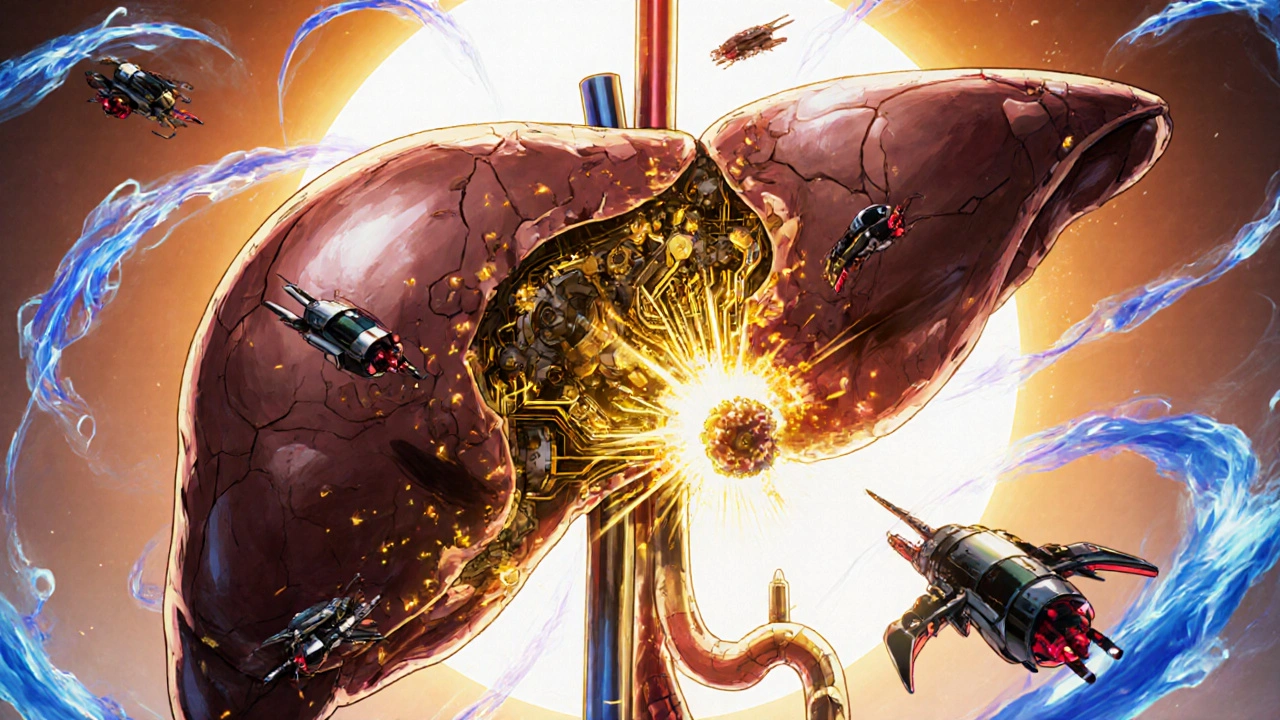

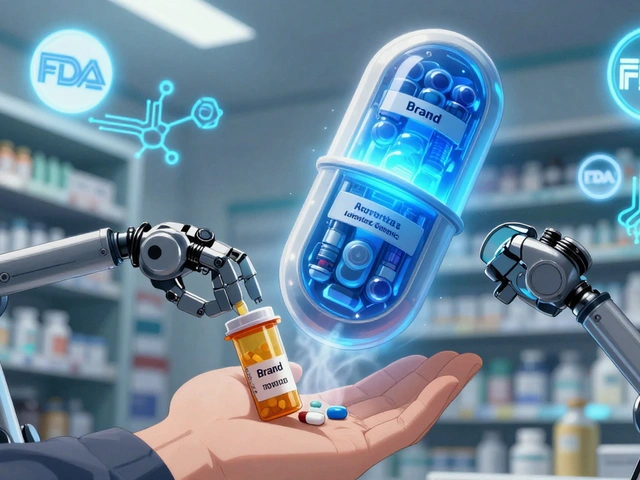
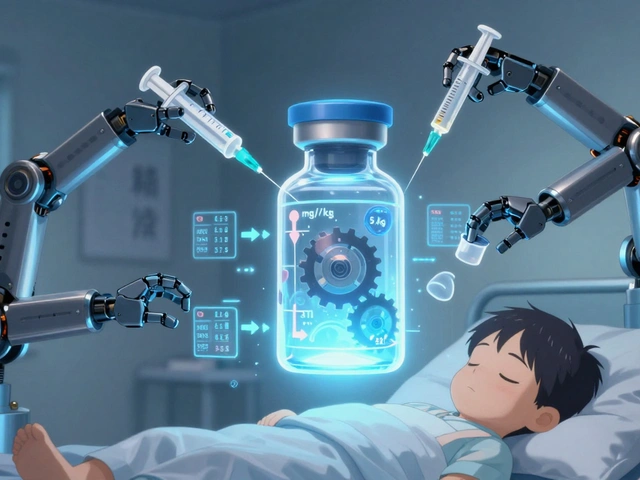
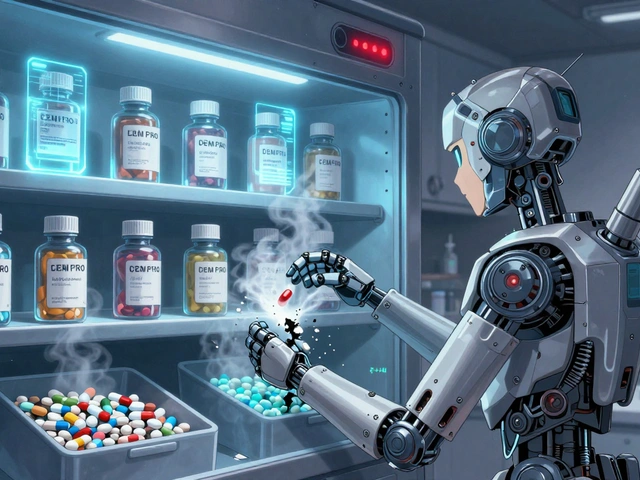

Andrew Montandon
November 20, 2025 AT 10:11Wow, this is actually one of the most hopeful medical stories I’ve read in years. I had a cousin who went through interferon-she lost 30 pounds, couldn’t sleep, and cried every night for months. She didn’t even cure. Now? My sister just finished Epclusa last month. She took the pill with her coffee, went to work, and didn’t even notice she was being cured. It’s insane how far we’ve come.
I’m telling everyone I know to get tested. Even if you feel fine. Even if you’re 60. Even if you think it’s ‘not your thing.’ You don’t need to be a junkie to get HCV. My uncle got it from a tattoo in ‘87. No one told him it could kill him slowly. Now he’s cured. And he’s dancing at his granddaughter’s wedding next month.
It’s not just about the liver. It’s about being able to hold your grandkid without fear. To tell your partner you love them without wondering if you’re a ticking time bomb. To sleep through the night. To stop Googling ‘liver cancer symptoms’ at 3 a.m.
And yeah, the cost is ridiculous. But if your insurance denies it, call your state health department. They have programs. I did. Got it free. No shame. This isn’t a luxury. It’s a right.
Also, please stop saying ‘you brought it on yourself.’ People get this from blood transfusions, childbirth, unsterile needles at beauty salons, even old dental tools. It’s not a moral failure. It’s a virus. And now, it’s curable.
Sam Reicks
November 21, 2025 AT 08:34they say its cured but whats really happenin here? the big pharma companies paid off the doctors and the fda to say its 95% effective but the real data is buried in the dark web. i saw a post on 4chan where a guy said he took the pills and his liver got worse. they deleted it. why? because they dont want you to know the truth. also the pills are laced with nanobots to track you. thats why theyre so cheap to make. its not about health its about control
Chuck Coffer
November 22, 2025 AT 12:03How touching. Another feel-good story from someone who clearly hasn’t spent five minutes reading a single clinical trial. 95%? That’s the headline. The real-world data? More like 80% if you factor in non-compliance, undiagnosed cirrhosis, and patients who stop because they ‘felt fine.’ And don’t get me started on the fact that 70% of those who ‘heal’ still have elevated liver enzymes. You think the liver regenerates? It fibroses. It doesn’t reverse. It compensates. Big difference.
And yes, the side effects are ‘mild.’ Until you’re the one with the headache that won’t quit, the depression that lingers, or the kidney issues from sofosbuvir. You think it’s a miracle? It’s a profit margin.
Marjorie Antoniou
November 23, 2025 AT 23:32I just want to say how much this post means to people who’ve been scared for decades. I was diagnosed in 2010. I didn’t tell anyone-not my mom, not my boyfriend, not even my therapist. I thought I was a burden. I thought I’d die alone. I finally got treated in 2020. It was easy. I cried the day I got my SVR results. Not because I was cured-but because I finally felt like I could breathe again.
If you’re reading this and you’re still hiding? You don’t have to anymore. Talk to your doctor. Ask for the test. It’s one blood draw. One conversation. One chance to rewrite your whole story.
Andrew Baggley
November 24, 2025 AT 15:16THIS. THIS IS THE KIND OF HOPE WE NEED RIGHT NOW. Seriously. In a world where everything feels broken-politics, climate, your Wi-Fi-here’s something that actually WORKS. No hype. No gimmicks. Just science. Pills. Results. Lives saved.
I’m not a doctor. I’m not even a nurse. But I work at a community center. We’ve helped 17 people get tested this year. 14 got treated. All 14 are cured. One guy? He started volunteering at the food bank after. Said he finally felt like he had something to give.
Don’t wait for symptoms. Don’t wait for insurance to say yes. Don’t wait for someone else to fix it. You can fix this. Today. Right now. Just ask.
Codie Wagers
November 25, 2025 AT 03:58There is a profound existential irony in the fact that humanity has unlocked the ability to eradicate a silent, slow-moving killer with a single pill-yet we continue to let bureaucratic indifference, profit-driven healthcare systems, and social stigma prevent its universal access. The virus was defeated by chemistry. But the human condition? That remains stubbornly, tragically uncurable.
We have the science. We have the will. But we lack the collective moral courage to treat a disease as a public good rather than a commodity. The pill is not the miracle. The miracle would be if we chose to give it to everyone.
Paige Lund
November 25, 2025 AT 10:27Wow. So now we’re supposed to be impressed that Big Pharma found a way to make people take pills instead of shots? Groundbreaking. Next up: a cure for ‘feeling bad about your life.’
Michael Salmon
November 27, 2025 AT 06:27Let’s be real. The ‘cure’ is a marketing ploy. These drugs don’t fix the liver-they just make the virus disappear. The fibrosis? Still there. The cancer risk? Still elevated. And the cost? $75K? For a 12-week course? That’s not medicine. That’s extortion. And the fact that you can now prescribe this to kids? That’s not progress. That’s corporate overreach.
Meanwhile, the real epidemic is opioid addiction and needle sharing. But no one’s talking about that. Why? Because treating addiction is expensive. Treating HCV with pills? Profitable.
They cured the virus. They didn’t cure the system.
Joe Durham
November 27, 2025 AT 21:32I’ve been in recovery from IV drug use for 8 years. I got HCV in 2012. Took the pills in 2021. Cured. No drama. No trauma. Just… done.
I get why people are scared. I was too. But this isn’t about being ‘clean’ or ‘deserving.’ It’s about being alive. I’ve met people who refused treatment because they thought they’d die anyway. They were wrong.
If you’re reading this and you’re still scared? I get it. But you’re not alone. Talk to someone. A nurse. A friend. A stranger on Reddit. Someone will help you.
You don’t have to be perfect to be worthy of a cure.
Christopher Robinson
November 28, 2025 AT 13:22Just got my SVR12 results yesterday 🎉 No more anxiety. No more ‘what ifs.’ Just… peace. Took the pills with my cat on my lap. She didn’t care. Neither did my liver. 😊
Also-huge shoutout to my primary care doc who didn’t make me jump through 17 hoops. Just said, ‘Here’s your script. Take it.’ That’s the future right there.
James Ó Nuanáin
November 30, 2025 AT 04:59While I commend the scientific advancement, one must acknowledge that the United States continues to lag behind the United Kingdom, Germany, and even Australia in terms of universal access and public health integration. Here, we have the technology, yet we permit a fragmented, profit-driven model to obstruct equitable care. This is not a medical failure-it is a moral failure of Anglo-American capitalism. The British NHS, for example, provides DAAs at cost, without prior authorization. One wonders why the U.S. persists in treating healthcare as a privilege rather than a right.
Nick Lesieur
November 30, 2025 AT 12:41so u say its 95% cure rate but what if u just got a headache and stopped takin the pills? then u r like ‘oh i guess i aint cured’ and then u go back to drinkin and getin tattoos and now ur back to square one. this whole thing is a scam. they just wanna sell more pills. also why is it called ‘epclusa’? sounds like a brand of toothpaste
Angela Gutschwager
November 30, 2025 AT 14:27My mom got cured. She’s 72. Took the pills for 12 weeks. No side effects. Now she bakes pies again. That’s it. That’s the whole story.
Andy Feltus
November 30, 2025 AT 18:57It’s funny how we celebrate a pill that cures a disease we’ve known about since 1989… but still can’t cure poverty, loneliness, or the fact that people die waiting for insurance approvals. We’ve mastered biology. But we’re still stuck in the Stone Age of ethics.
The real miracle isn’t the drug. It’s the fact that someone, somewhere, decided that a human life was worth more than a profit margin.
Let’s not forget that.
Dion Hetemi
December 2, 2025 AT 11:03Let’s be honest-this isn’t about curing hepatitis C. It’s about turning patients into consumers. You get a pill. You feel better. You think you’re fixed. But the system? It’s still broken. You still need to fight insurance. Still need to prove you’re ‘worthy.’ Still need to beg for help. The virus is gone. But the bureaucracy? Still alive and well.
And don’t get me started on the ‘reinfection’ rates among IV users. We’re not treating the root cause-we’re just patching the leak while the whole damn pipe is rusted through.